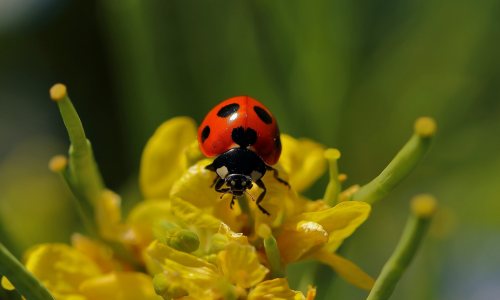Updated on September 13, 2024
You wake during the night, hearing the rush of wind as it battles through the thick evergreen trees that stand guard around the perimeter of your Pacific Northwest cabin. In the morning, you find your home bathed in sunlight and surrounded by a depth of snow that astonishes you. Yet, after a week of listening to the crackle of firewood late into the night, enjoying the occasional hot toddy (that darn head cold) and watching the snow earnestly melt as though it yearned to turn back into its former liquid self, you discover that this supposedly harsh winter season is beginning to feel surprisingly warm.
Why am I seeing small brown bugs in my house?
As you ponder the perplexity of the seasons, you can’t help but notice a narrow line of little shield-shaped, flat, brown bugs making their way across your barren wood floor. There are but three of them, quite clumsy looking and slow moving, but they are clearly making their way towards the warmth of your stove. They are stink bugs—brown marmorated stink bugs.

As the kettle warms on your stove, you choose to ignore the tiny invasion that’s happening within the four walls of your kitchen. Slipping your feet into your fur-lined sheepskin slippers and pretending that there’s still a harsh wind outside that's rattling your window panes and creating startling snow accumulation (rather than embrace this absurdly warm January day), you make your way to the lavatory. There, on the shower wall, you see a bright red Asian lady beetle. Its presence is painfully undeniable. Its deep red hue moves slowly in stark contrast to the sand-colored tiles that line the frame of your shower.
These cabin-invaders, believing that spring has arrived, are awakening from their slumbers, eager to be outdoors and search for their first hearty meal and mate.
While you navigate your unusually warm winter cabin, it's not just the Asian lady beetles that are out of place. Several other critters, deceived by the warmth, are making appearances too. Here's who else might be joining you this winter, mistaking your cozy retreat for their springtime revival.
Why are tiny black bugs congregating near my windows?
These tiny household bugs are congregating near your window sills for the same reason that I found stinkbugs in my kitchen and an Asian lady beetle in my bathroom. This particular bug—slightly larger and darker than the common housefly—is a cluster fly and another species of bug (in addition to stink bugs and Asian lady beetles) that likes to overwinter in homes.
They are attracted to your window panes because they’re either temporarily seeking the warmth of the sunshine that is blissfully pouring through or they’re truly believing that spring has sprung and are looking for a means to get out of your home.
As you ponder these misguided winter visitors like the cluster flies, you might wonder who else could be lurking around. Well, not all guests are as noticeable. From boxelder bugs to the quieter elm leaf beetles, let's explore the variety of overwintering bugs that might be quietly residing in your attic or crawlspace, all thinking it's time for spring.
What other bugs might wake up in my home?
Stink bugs, Asian lady beetles and cluster flies, as mentioned above, as well as boxelder bugs and the occasional elm leaf beetle are the most common types of overwintering bugs that will merrily find their way into your homes, preferably your attic or crawlspace, and stay there—all winter long.

Other bugs that you may encounter indoors during the cooler months include:
- Spiders: Some live their entire lives indoors
- Bed bugs: They survive year-round
- Cockroaches: Cold weather drives them indoors
- Silverfish: They seek the warmth and food a home provides
- Earwigs: They tend to hibernate outdoors, but can also be found in homes
- Pantry pests: Due to heated homes, these common household pests are a year-round problem
Where else do bugs go for the winter?
Bugs want to survive the winter. If they’re unable to, they die. Those that are able to survive can be found underground, behind tree bark, in their nests or in another location that provides the protection they need.
Following are the names of several bugs, ranging from the tiny cluster fly to the large New Zealand weta, (measuring nearly four inches long) and the places, aside from your home, that they will go.
- June bugs burrow into compressed snow, trapping the air and creating insulated pockets.
- Ants and termites drop below the frost line, where their large numbers and stored food keep them comfortable until spring arrives.
- The New Zealand weta, a type of flightless cricket, freezes solid under large stones.
- Praying mantises survive as eggs on twigs, stems, rocks or even fence posts, emerging as larvae in the spring.
- Bees shiver in their hives and consume up to 30 pounds of stored honey.
- Most species of flies bury themselves one to six inches beneath the soil in their third—or pupal—stage of development.
Are those bugs in my house a problem?
Believe it or not, the five common overwintering bugs—stink bugs, Asian lady beetles, cluster flies, boxelder bugs and elm leaf beetle—are typically not problematic, as they are generally not active in the winter. They quietly slip in during the fall and then back out in the spring, often without the homeowner ever noticing their presence
During this period, these five overwintering pests:

- Will not lay eggs
- Will not eat or infest your food
- Will not create nests or breed
- Will not cause any structural or ornamental damage
- Will not bite
Unfortunately, this is not the case for spiders, bed bugs, cockroaches, silverfish, earwigs or pantry pests. These critters remain active year-round. This is indeed a problem, as they will breed and multiply until you put a stop to their indoor nonsense.
This is also not the case when the winter weather, that (depending on where you live) is supposed to be mitten-wearing, icicle-creating and carrot-nose-snowman-building, turns wrongly and oddly warm and these critters wake up; the kind of weather that makes you want to slip into a pair of board shorts, pull on your favorite threadbare college t-shirt and head out for a game of pickleball.
How do I get rid of bugs that wake up in my house?
There are several ways in which you can get rid of these bugs, regardless of whether it’s one of the five overwintering bugs or the others (spiders, bed bugs, cockroaches, silverfish, earwigs or pantry pests) that remain active year-round.
Spray Six Feet Under Non-Toxic Insect Spray: If these bugs are not in wall voids or other locations where they will die (post being sprayed) and attract other bugs, you can kill them with our non-toxic kill-on-contact spray. It is a reliable indoor bug killer that can safely be used around your children and pets.
Use The Fly Inn: Cluster flies make their debut in the fall and will fly towards sunny locations in your home. Attaching a Fly Inn to these sun-filled windows will drastically reduce the number of flies (and other winged invaders) that you’ll find yourself swatting this winter.
Vacuum them up: Some of these bugs, such as the stink bug, are not pleasant smelling. Others, such as the Asian lady beetle, will bite when feeling threatened. Vacuum them up and either release them outdoors or place them in a plastic bag and dispose of this bag in an outdoor garbage can.
Find their entry point: Though you will probably have to wait until the spring to address this problem, it’s wise to devise a plan now. These bugs are somehow finding entrance into your home. Here are the most common entry points:- Through the eaves
- Through a gap in a door or window
- Through an unsealed point in your attic
- Through a crack in your wall
You may need to create a list of spring-time-house-repairs to keep (future) bugs out of your home. In the meantime, I recommend purchasing the Insect Buster Bulb Duster and dispersing our non-toxic insect powder, Dust to Dust Plant-Powered Insect Powder, in any cracks and crevices on both the interior and exterior of your home, as well as in any gaps around your door and window frames. You could even lay a soft line of this insect powder around the perimeter of your home.
Dr. Killigan's Dust to Dust Non-Toxic Insect Powder is a safer and more effective alternative to diatomaceous earth for insect control. Dust to Dust is proven to have kill times up to 50% faster than diatomaceous earth.
If all else fails, feel free to email our customer service team at support@drkilligans.com. We stand at the ready to help you achieve a bug-free home.






















